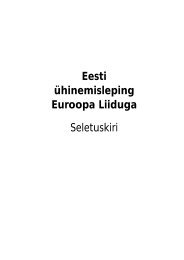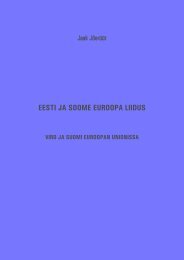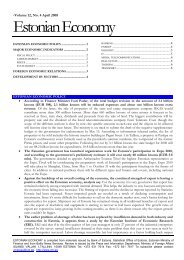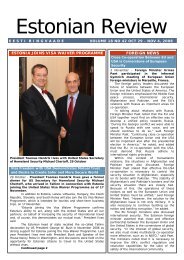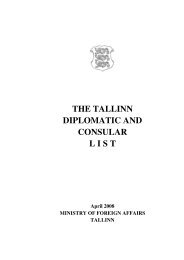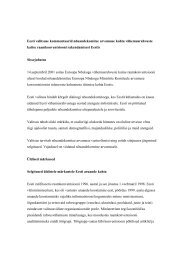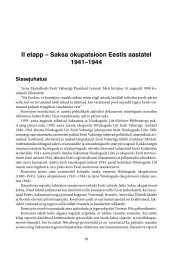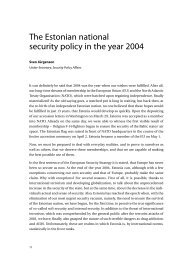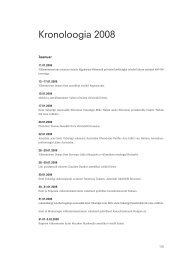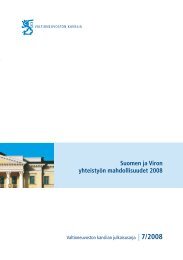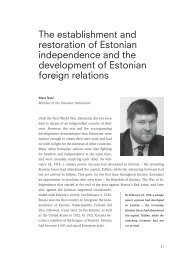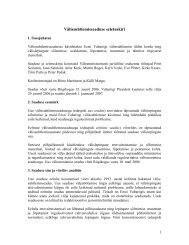Opportunities for Cooperation between Estonia and ... - Valitsus
Opportunities for Cooperation between Estonia and ... - Valitsus
Opportunities for Cooperation between Estonia and ... - Valitsus
Create successful ePaper yourself
Turn your PDF publications into a flip-book with our unique Google optimized e-Paper software.
APPENDIX 12<br />
TOURISM<br />
Tourism is commonly understood to mean holidaymaking <strong>and</strong> recreation away<br />
from home, but it can sometimes cover business travel too. Tourism consists<br />
not only of the actual travel but also the provision <strong>and</strong> use of various services.<br />
Sometimes tourism is simply defined as any trip extending more than 80 km<br />
from the traveller’s home <strong>and</strong> involving a stay at the destination of less than<br />
one year.<br />
Tourism is not just a developing business sector. It contributes substantially<br />
to the international perception <strong>and</strong> image of travel destinations <strong>and</strong> areas.<br />
Developing tourism <strong>between</strong> <strong>Estonia</strong> <strong>and</strong> Finl<strong>and</strong> is important <strong>for</strong> the promotion<br />
of integration <strong>between</strong> the two countries.<br />
Tourism is principally of financial importance <strong>for</strong> <strong>Estonia</strong> <strong>and</strong> Finl<strong>and</strong>. In 2007,<br />
tourism accounted <strong>for</strong> about 8% of the <strong>Estonia</strong>n GDP <strong>and</strong> 2.4% of the Finnish<br />
GDP. Last year, tourists logged 5.3 million overnights in Finl<strong>and</strong> <strong>and</strong> 2.9 million<br />
in <strong>Estonia</strong>. In 2007, a total of 1,656,000 Finns visited <strong>Estonia</strong>; some 53% of<br />
them stayed overnight, the rest were day-trippers.<br />
Although <strong>Estonia</strong> <strong>and</strong> Finl<strong>and</strong> are to some extent competitors in the tourism<br />
industry, they are perceived as a single destination at least by tourists from<br />
outside Europe. Because of this, the public tourism authorities <strong>and</strong> tourism<br />
businesses in <strong>Estonia</strong> <strong>and</strong> Finl<strong>and</strong> should find out how they could pool their<br />
resources. The aim might be to develop a common marketing strategy <strong>and</strong><br />
shared procedures. <strong>Cooperation</strong> <strong>between</strong> the <strong>Estonia</strong>n Tourist Board (Eesti<br />
Turismiarenduskeskus) <strong>and</strong> the Finnish Tourist Board (MEK) should be<br />
considerably enhanced.<br />
Helsinki <strong>and</strong> Tallinn are already considered twin cities by many tourists, because<br />
their sights <strong>and</strong> services complement one another. This should be seen as an<br />
opportunity <strong>for</strong> the Helsinki City Tourist & Convention Bureau <strong>and</strong> the Tallinn<br />
Tourist Bureau (Tallinnan Ettevõtlusameti turismiosakond) to join <strong>for</strong>ces in<br />
marketing the twin cities in overseas markets. Many tourists also consider<br />
the opportunity of adding St Petersburg or Stockholm to a trip to Helsinki <strong>and</strong><br />
Tallinn, <strong>and</strong> this ‘triangle concept’ should be exploited in developing tourism in<br />
<strong>Estonia</strong> <strong>and</strong> Finl<strong>and</strong>.<br />
Travel by <strong>Estonia</strong>ns <strong>and</strong> Finns across the Gulf of Finl<strong>and</strong> is important not<br />
only <strong>for</strong> enlivening the tourism sector but also <strong>for</strong> the integration of the two<br />
57



